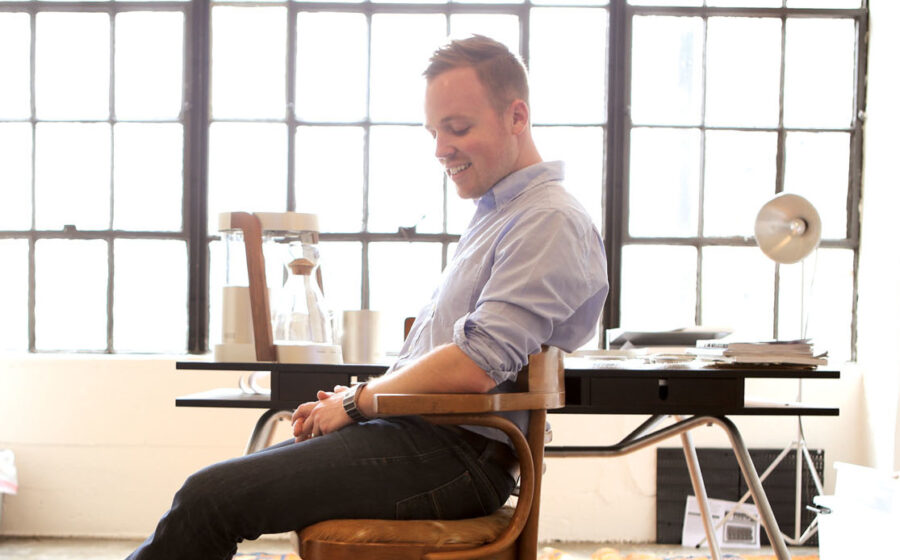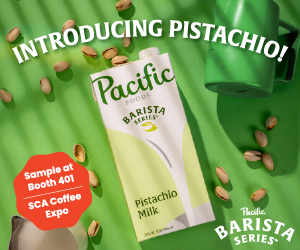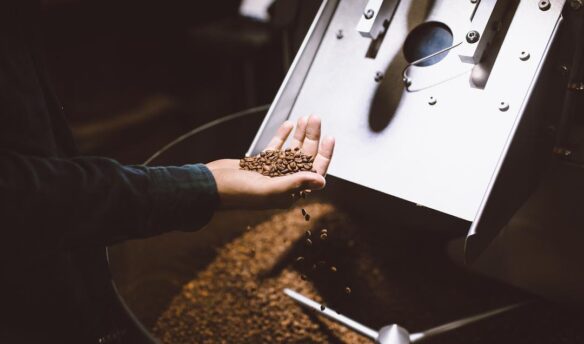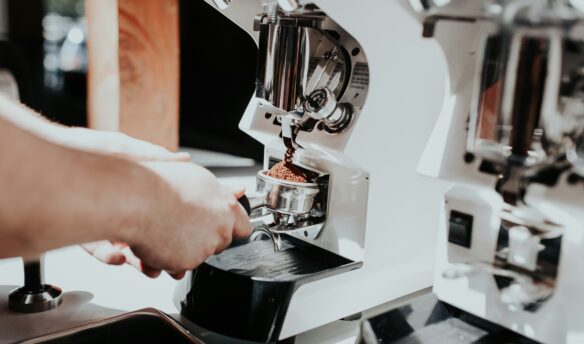[M]ark Hellweg is standing over a gutted Ratio Brewer, picking up minute machine pieces from a table strewn with packaging materials, Rhodia writing pads, design magazines, and pre-production parts for his newest invention. The Ratio—which debuts this summer after several years in planning and halting production—is the at-home brewer that launched Portland’s Ratio Coffee, Mark’s second startup dedicated to home-brewing equipment.
Clive Coffee, the entrepreneur’s original equipment company, is just across the street on Water Avenue, a concentrated boulevard of good food and drink. At Clive a minimalist showroom of sleek gadgets—from Hario pour-overs to state-of-the-art single-group espresso machines—invites passersby into a realm of coffee artistry. Vases of reaching, exotic flowers and a turntable spinning jazz make shopping for an Aeropress a tranquil experience, akin to an afternoon museum stroll.
In contrast, the Ratio office, an industrial yet cozy room overlooking the Willamette River, is strewn with various steel parts, half-opened boxes, and bubble wrap. If Clive is a venue to showcase the industry’s finest brewing goods, Ratio is a design house where the bar for those goods is being raised. The mess is a byproduct of the Ratio finally coming to fruition. Once these parts are approved, they will be shipped to Portland from across the globe, assembled by hand, and the machines will be sent to more than 500 eager customers.
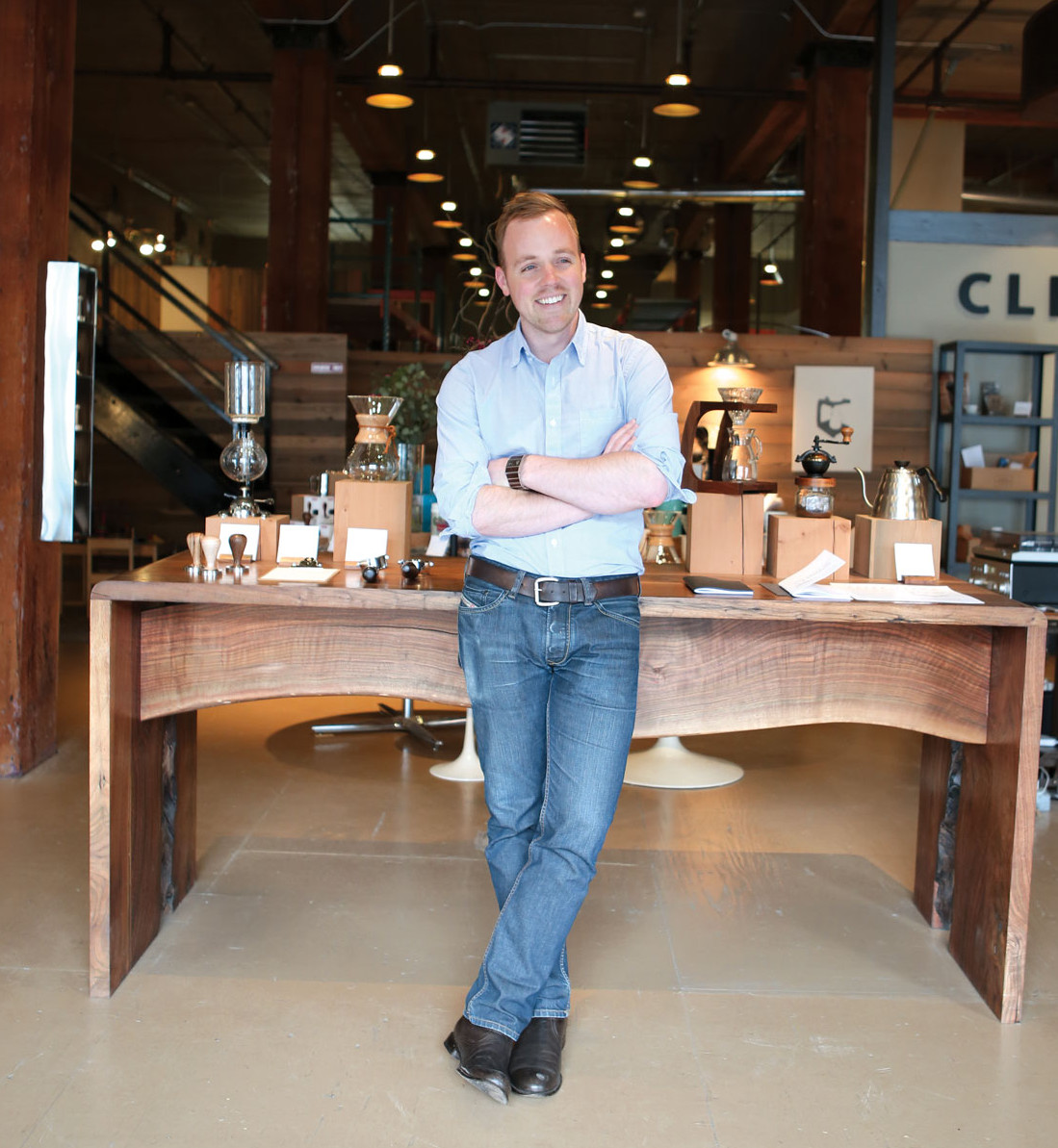
Mark has an easy sense for aesthetics. He converted his garage at home into a library, where he spends hours reading and smoking a pipe. He loves to oil paint. He calls himself “an old soul” who most appreciates products that hold a legacy, or have the sensibilities to create one. His clean-cut appearance is offset by his warm personality—he professes to be OCD about presentation, apologizing for the clutter, but as he stands over a pre-production model of the Ratio that’s half assembled, he is nothing but enthusiastic about the beautiful mess within.
“This is our new showerhead,” he says, holding up a plastic, 3-D–printed model of a two-inch, spiral-dotted disc. “You’re the first to see it,” he adds, flashing an easy grin. The Ratio’s first showerhead (which douses coffee grounds with precisely-heated water in a fashion mimicking a manual pour-over) wasn’t as efficient if the machine was on a non-level surface. At a slight tilt, the coffee wasn’t saturated quite right, so the team went back to the drawing board.
The Ratio is the futuristic progression of pour-over coffee’s increasing prominence, with the potential to eventually rework the idea of what a home coffee machine can be.
This is just one example of the attention to detail given to the much-talked-about machine, and to the intensity of its production. Externally, the Ratio Brewer is minimalist. A steel and Oregon-walnut body perfectly frame the hand-blown borosilicate glass water chamber and serving vessel. One button activates an illuminated panel reading bloom, brew, and ready.
But it’s clear amidst the machine’s internal hardware that the inside of the Ratio is not just technologically advanced, but unique to its category. Hundreds of pieces contribute to the functionality of an easy-to-use coffee machine that is both an art piece, and an automated, kitchen-friendly translation of the third-wave coffee experience.
“There is a charm in the quality of some coffee-brewing devices—a Chemex, a Japanese pouring kettle, a wood tamper—there are some tools that have a certain presence to them,” Mark says. “We wanted to take that from the manual brewing world, basically pour-over, and apply that to a coffeemaker.”
Through the Ratio—and its co-branded line of coffee goods that are slated to follow—Mark is bringing to personal brewing what Apple brought to personal computers. Beauty meets high-level functionality, but that beauty extends to the smallest detail, and even on the inside the Ratio’s “particular design language” impresses.
“We have concentric circles, the use of precision machine metal parts contrasted with more organic wood and glass, we have almost a Stockholm aesthetic going on, we have a definite approach to simplicity and reliability,” says the Bay Area native, who is happiest when he has a variety of projects to work on simultaneously.
Mark inherited his love of design and quality craftsmanship from his maternal grandfather, an aspiring architect turned hand surgeon who bequeathed many of his original sketches to his grandson. One of these pieces, a watercolor drawing of a San Francisco Victorian, hangs in the Ratio office.
His father was a stickler for quality products, with a home full of Bosch tools and a credo that “once you’ve experienced quality, you’ll never go back.” Mark got his first taste of business at his brother’s company, a snowboard and wakeboard business, but it was a love of experiential beauty—particularly, the tradition of coffee—that sent him down his current path.
With Clive, the brand he launched in 2008, that meant sourcing and selling the best coffee machines out there, starting with the Technivorm, a coveted brewer that put Clive on the map after Cooks Illustrated, in a test of automatic coffee brewers, said “only [it] gave us great coffee.” (A 2013 update of the review again placed it at the top of the pack.)
At the helm of Ratio, it means getting comfortable with patience. The Ratio and future products of its ilk are intended to last for decades, with tough materials and parts easy to mend. That kind of meticulous craftsmanship requires more effort, more time, and appreciation for the process.
Though the Ratio has taken its time getting to market (the concept was devised in 2009, and shipment has been pushed back several times), the build up for a different kind of drip brewer has been more than enough reward, with roasters, cafés, and equipment retailers across the world clamoring for a chance to carry the machine.
Maybe it’s the look of the Ratio, which implies potential for better home-brewing equipment overall. Maybe it’s the concept of a “family” of products that Apple made so famous, and seeing that bleed over into coffee preparation.
Either way, the Ratio—and the products highlighted by Clive—are helping to bring quality and high aesthetics to automatic brewing. The Ratio is the futuristic progression of pour-over coffee’s increasing prominence, with the potential to eventually rework the idea of what a home coffee machine can be.
When asked if he would ever move beyond coffee, to create gadgets for other uses, Mark pauses, smiles, and shakes his head. “I think I’m in it. It never gets old for me to see someone discover good coffee for the first time. The more followers of coffee I can inspire, I’m super excited about that.”
—Regan Crisp is Fresh Cup’s associate editor.


